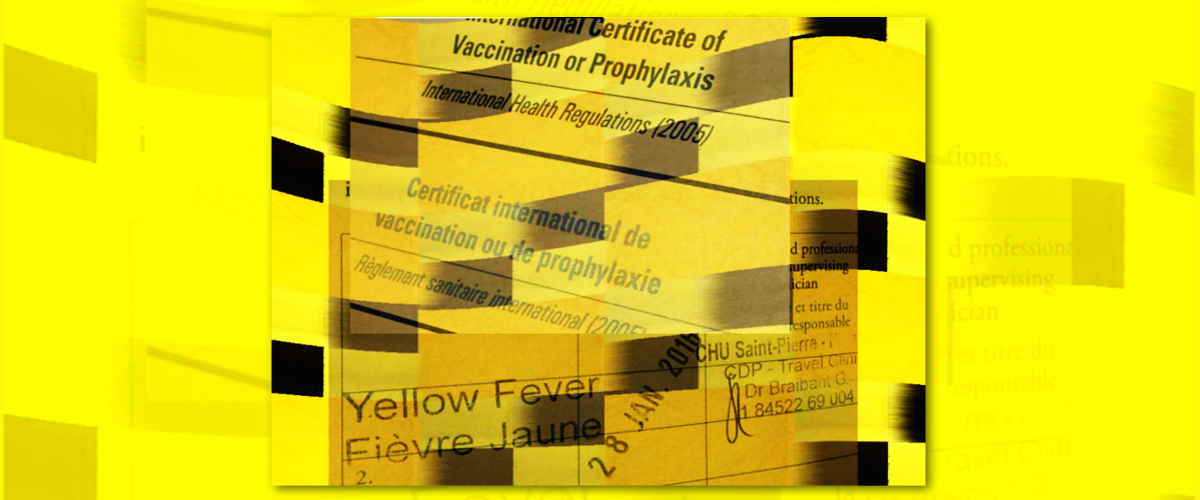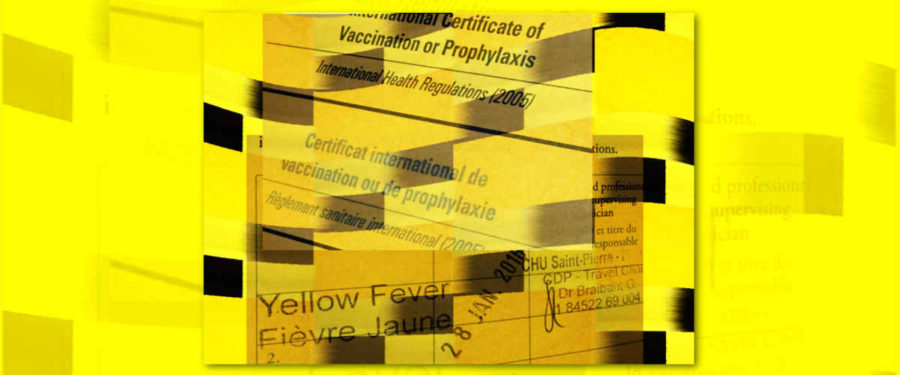The Travellers’ Clinic
There was a queue of five outside the door of the Saint Pierre hospital’s Travel Clinic at 8.30 when they opened, and two more people and a family walked in directly after. Even though I had misread the opening times and been there since 8 o’clock, I still wasn’t first in line. Not that I was in a great hurry. I took my queue ticket and settled in the waiting room, watching the long ad for National Geographic that was looping on the TV screen. The American voices on the ad were muted but still audible under the French voice-overs. This, of course, was why we were here. All of us. The dream of travelling the world to film ring-tailed lemurs in Madagascar, swim with whales off Baja California, fly with condors in the High Andes…
Well, perhaps not.
Most of my waiting-room fellows were French speakers, so, though I could overhear their conversations with the receptionists, I couldn’t understand what they said. Still, one worried looking young man cautiously picked his way through an explanation in English about losing his vaccination card, while the family turned out to be Canadians resident in Brussels but now on their way to Sri Lanka on a diplomatic posting.
Colours
My conversation with the receptionist (limping French and halting English) resulted in a form to fill out. Country of destination? Date of departure? Staying in the city or visiting the countryside? In hotels or with locals? Have you ever hade an inoculation for… and a list of diseases from mumps and measles via tetanus to cholera, hepatitis and rabies. There were clipboards and pens to borrow, The pens were with either red ink or green. I hesitated. Green seemed more appropriate somehow, healthier, but in the end I went for red. The colour of blood. (Not really, I know.)
The international vaccination card (Carte Jaune in French) – effectively a medical passport – is yellow. A rather dull and dirty yellow, mine anyway. You may already know this, but it was news to me when I eventually received mine. The colour was almost more interesting, I thought, than the conversation I had with the doctor about what vaccinations I ought to have.
I ended up with tetanus, (My old friend – can it be nearly twenty years since last? Yes, it can. Bitten by a dog while walking Hadrian’s Wall – but that’s another story.) And yellow fever.
Yellow fever
Now, I know I’ve been inoculated against yellow fever before. It was when I was five-years-old and in preparation for our trip to Ghana. I remember it because I had a nasty local reaction to the jab, which seemed to be very deep and painful and produced a scab that left a scar. Theoretically, one yellow fever inoculation should last a lifetime, but with no documentation (come on, it was 53 years ago) it’s better to get the jab again and get a vaccinations card to prove it.
In fact, yellow fever is the one vaccination that is required for the vaccination card. Admiring the stamp in my card, I couldn’t help thinking there must be a connection – I was sure I’d read about it – a connection between the yellowness of the vaccination card and the yellowness of yellow fever. I was sure. I was certain. But I was, it turned out, wrong.
Well, right, in a kind of roundabout way, but mostly wrong.
Once upon a very long time ago – possibly as far back as the early Middle Ages – people in Europe started to use a yellow mark or a flag as a plague warning. Houses where plague had broken out might be marked with a yellow cross, towns that were suffering from the plague might fly a yellow flag, warning visitors and travellers to keep their distance. Later hoisting an all-yellow flag (called the yellow jack in English) was a sign that there was plague on board a ship.
Plague
Now, plague doesn’t have to mean bubonic plague. Many things can plague us. Certain pop songs and advertising jingles come to mind. The Biblical plagues of Egypt included locusts and lice as well as boils and death.
From the end of the 15th century, as people learned to sail around the world, diseases from one place could easily be transported to another, where people had no resistance, and wipe out millions. Smallpox was one of Europe’s plague gifts to the Americas. Yellow fever was one of Africa’s plague gifts to Europe and the European colonists.
What yellow fever does to you, among other things, is attack your liver. This affects your blood supply because your liver is the organ where your body filters out old blood cells. When the liver stops doing its job because it is under attack, old blood cells are not cleaned up properly. With a build up of old blood cells, your skin will begin to look increasingly yellow. Hence yellow fever. (Hepatitis and some other diseases do the same thing with much the same result.)
The yellow jack
Yellow fever became a major terror in the 18th and 19th centuries. In cases where it was introduced to a population that had no resistance, it could have a mortality rate of 50% or more. Consequently, ships carrying passengers or crew who had gone down with yellow fever would raise the yellow jack when they came to a port, announcing their intention to go into quarantine.
From this comes one of the alternative names for yellow fever – yellow jack. Also the letter that the all-yellow flag signifies in flag semaphore – Q (for quarantine).
Customs change. Nowadays (so I am reliably – ahem – informed by Wikipedia) ships with disease aboard will fly a black-and-yellow checked flag (which signifies L – for leprosy – by the way). The all yellow flag nowadays indicates the ship believes it is now free of disease and is requesting a doctor’s visit to confirm this. In other words, the yellow jack is now a sign of health.
Which is why the international vaccination card is yellow – to show that the bearer is protected.
Flavavirus
I have spent hours chasing after all this on-line – especially, I tried to find out why yellow, of all colours (it’s the colour of the sun and summer, damn it!) Why yellow has been associated in the West with disease. I turned up nothing definite there. But did you know that yellow fever, dengue, and the new media sensation zika are all related? All produced by strains of the flavivirus. Talk of a soon to be discovered vaccine for zika is based on the fact that we have an effective vaccination for yellow fever, but dengue has been with us as long as yellow fever and for dengue there is still no effective vaccine. So… don’t hold your breath. And try not to get bitten by mosquitoes wherever you may be travelling.
And why am I getting myself a yellow card and a yellow fever inoculation? I’m glad you asked! I’m setting out to collect a series of new and boosted vaccinations because I am rather hoping to be travelling back to Africa this year, next year, sometime…
My goal is to return to Ghana.
It’s now 52 years since I was there and I have been toying with the idea of going back for more than 10 years. I’m hoping 2016 or 2017 will be the year I finally do it. Inoculating myself is a first step on the way.
This article was written for the #Blogg52 challenge.
I originally published this article on the separate Stops and Stories website. Transferred here with a little polishing for SEO and a new featured image 5 November 2017.



Du höll oss på sträckbänken in i det sista … VARFÖR ska han vaccinera sig??? Resa till Afrika, ja det vore en dröm, vi har ett SOS barn där som inte är barn längre utan över 25. Men behövs det verkligen vaccinationskort nu? Jag trodde det bara var hundar och katter som behövde kunna visa upp sånt (kom på det när jag läste rabies …).
Hade en liknande erfarenhet som din i barndomen. Sonen till städerskan på pappas jobb (stadskontoret i Huddinge) hade kommit hem från en lång resa och medförde som en gåva smittkoppor. Enkel vaccination, de bara rispade i huden. Men sen … En jättekoppa i regnbågens alla färger som tog uppemot trettio år på sig att blekna till hudfärg. Borde fortfarande duga som gult kort …
Lycka till med resplanerna!
Ha! Glad that worked, delaying the explanation of what I was doing. 🙂
I’m afraid that vaccinations are a must for many places in the world. As far as yellow fever goes, it’s endemic in a lot of tropical countries, sadly Ghana is one. Also, many countries where it isn’t found still want you to be protected against it. Even if you are flying from a country that doesn’t have yellow fever (Belgium) to another country that doesn’t have it (South Africa for example), if your plane has to land in a country that does (Ghana, say), you can then be refused entry to your final destination if you don’t have the inoculation.
Smallpox was a dreadful disease. I’m not surprised the inoculation caused a serious reaction… but 30 years, I wouldn’t have guessed!
Thanks for your good wishes Eva. I suspect – if the trip goes ahead – there may be some reports published here.
Underbart inlägg! Du har alltid så intressanta, lärorika saker att berätta. Hoppas du kommer iväg till Afrika snart!
Kram Kim 🙂
Tack Kim!
Hmm, red blood cells are produced not in the liver, but in bone marrow 😛 Otherwise a wonderful story, as usual!
Woops! Thanks for spotting that Aleks. Much appreciated. I’ve fixed the mistake now.
🙂